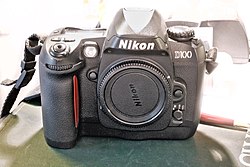 | |
| Overview | |
|---|---|
| Maker | Nikon Corporation |
| Type | Digital single-lens reflex |
| Lens | |
| Lens | Interchangeable, Nikon F-mount |
| Sensor/medium | |
| Sensor | Nikon DX format 23.7 mm × 15.6 mm CCD |
| Maximum resolution | 3,008 × 2,000 (6.0 megapixels) |
| Film speed | 200-1600 ISO in 1/3EV steps, 6400 special mode |
| Storage media | CompactFlash (Type I or Type II) or Hitachi Microdrive |
| Focusing | |
| Focus modes | CAM 900, standard Nikon AF |
| Exposure/metering | |
| Exposure metering | 10 segment |
| Shutter | |
| Shutter | vertical-travel focal-plane shutter |
| Shutter speed range | 30 to 1/4000s, bulb mode |
| Continuous shooting | 3 frame/s (6 frame buffer) |
| Viewfinder | |
| Viewfinder | 95% frame coverage, 0.8× magnification, Optical pentaprism |
| General | |
| LCD screen | 1.8-inch (46 mm) 118,000 pixel TFT |
| Weight | approx. 700 g |
| Made in | |
| Chronology | |
| Successor | Nikon D200 |
The Nikon D100 is a discontinued 6-megapixel digital single-lens reflex camera made by Nikon Corporation and designed as a consumer alternative to the professional D1 series cameras. It was the precursor of both the more advanced D70 and D200 cameras with the former continuing the consumer offerings and the latter beginning an advanced consumer and professional lineup. The D70 kept the controls which the D100 inherited from the F80 film camera, which has evolved into the current D7500 and D750 offerings, in cropped frame and full frame respectively. The D200 adopted the controls of the D1 series.